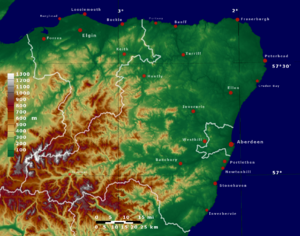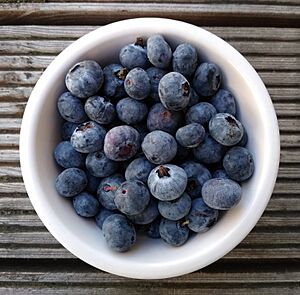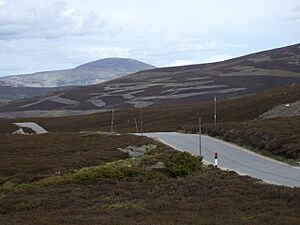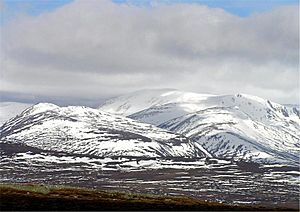Aberdeenshire facts for kids
Quick facts for kids
Aberdeenshire
Aiberdeenshire Siorrachd Obar Dheathain |
||
|---|---|---|
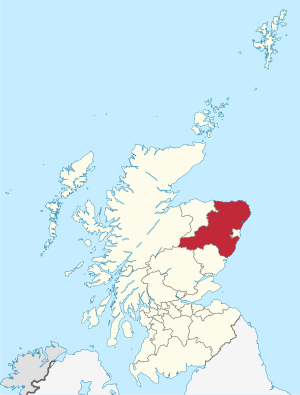 |
||
|
||
| Sovereign state | United Kingdom | |
| Country | Scotland | |
| Lieutenancy areas | Aberdeenshire, Banffshire (Part), Kincardineshire | |
| Admin HQ | Aberdeen | |
| Government | ||
| • Body | Aberdeenshire Council | |
| Area | ||
| • Total | 2,437 sq mi (6,313 km2) | |
| Area rank | Ranked 4th | |
| Population | ||
| • Total | 261,470 | |
| • Rank | Ranked 6th | |
| • Density | 107.271/sq mi (41.418/km2) | |
| GSS code | S12000034 | |
| ISO 3166 code | GB-ABD | |
Aberdeenshire (Scots: Aiberdeenshire; Scottish Gaelic: Siorrachd Obar Dheathain) is one of the 32 council areas in Scotland. It is named after the historic County of Aberdeen, but its borders are a bit different today.
The Aberdeenshire Council area includes most of the old counties of Aberdeenshire and Kincardineshire. It also has a part of Banffshire. The old county borders are still used for things like land records.
The main office for Aberdeenshire Council is in Aberdeen. This is interesting because Aberdeen itself is a separate council area. Aberdeenshire shares borders with Angus and Perth and Kinross to the south. To the west, it borders Highland and Moray. To the east, it touches Aberdeen City.
For a long time, Aberdeenshire's economy relied on farming, fishing, and forestry. In the last 40 years, the oil and gas industry has grown a lot. This has helped Aberdeenshire's economy become more diverse. Its population has also grown by about 50% since 1975. Aberdeenshire covers about 8% of Scotland's total land. It is about 6,313 square kilometers in size.
Contents
History of Aberdeenshire
Aberdeenshire has a very old history. Many ancient sites from the Neolithic (New Stone Age) and Bronze Age can be found here. These include places like Longman Hill and Cairn Lee. Around 2000–1800 BC, people from the Beaker culture settled in the area. They built stone circles and cairns (stone mounds). Later, in the Iron Age, people built hill forts.
Around the 1st century AD, a group called the Taexali lived along the coast. The Picts were another important group who lived here by 800–900 AD. The Romans also visited the area, leaving signs at Kintore. Christianity arrived early, and there were Celtic monasteries at Old Deer and Monymusk.
Since medieval times, many old paths have crossed the Mounth. This is a mountain range that goes from the higher inland areas to the North Sea. These paths connected the Scottish Lowlands to the Highlands. Famous paths include the Causey Mounth and Elsick Mounth.
Aberdeenshire was important in the fights between Scottish clans. The Clan MacBeth and the Clan Canmore were two big clans. Macbeth was defeated at Lumphanan in 1057. Later, new families like the House of Balliol, Clan Bruce, and Clan Cumming arrived. During the Scottish Wars of Independence, the English king Edward I visited the area twice. In 1307, Robert the Bruce won a battle near Inverurie.
These new families caused rivalries in the 14th and 15th centuries. These conflicts got worse during the Protestant Reformation. Religion became another reason for clans to fight. For example, the Gordon family was Catholic, and the Forbeses were Protestant. Three universities were started here before the 17th century: King's College (1494), Marischal College (1593), and the University of Fraserburgh (1597).
In the 17th century, more fighting happened in Aberdeenshire. This was mainly about the Marquess of Montrose and the Wars of the Three Kingdoms. During this time, the area also became richer from trading with Germany, Poland, and the Low Countries.
After the Glorious Revolution in 1688, there was a long period of peace. Only small events like the Rising of 1715 and the Rising of 1745 broke this peace. These risings led to the end of the old feudal power of landowners. After this, farming and industry grew a lot.
The current council area is named after the historic county of Aberdeenshire. This old county stopped being an administrative area in 1975. It was replaced by Grampian Regional Council and five smaller councils. In 1996, these smaller councils were combined to form the current Aberdeenshire Council area.
People and Population
The number of people living in Aberdeenshire has grown by over 50% since 1971. It is now about 261,470 people. This is about 4.7% of Scotland's total population. Since 2001, Aberdeenshire's population has increased by 9.1%. Scotland's total population grew by 3.8% in the same time.
Aberdeenshire has a higher number of people under 16 years old. It has slightly fewer working-age people compared to the average for Scotland.
In 2011, most residents (82.2%) said they were 'White Scottish'. Another 12.3% were 'White British'. Only 0.9% of the population were from ethnic minority groups. The largest ethnic minority group was Asian Scottish/British, at 0.8%. Besides English, 48.8% of people said they could speak and understand the Scots language.
Towns and Villages
The biggest towns and villages in Aberdeenshire are:
| Settlement | Population | |
|---|---|---|
| Mid-2010 | (2020) | |
| Peterhead | 17,790 | 19060 |
| Inverurie | 11,590 | 14660 |
| Fraserburgh | 12,540 | 12570 |
| Westhill | 11,220 | 12110 |
| Stonehaven | 10,820 | 11150 |
| Ellon | 9,910 | 10070 |
| Portlethen | 7,130 | 8940 |
| Banchory | 7,030 | 7440 |
| Kintore | 4,180 | 4700 |
| Turriff | 5,020 | 4700 |
| Huntly | 4,570 | 4550 |
| Banff | 3,720 | 4000 |
| Kemnay | 3,710 | 3890 |
| Macduff | 3,910 | 3830 |
| Laurencekirk | 2,650 | 3140 |
| Oldmeldrum | 2,990 | 3120 |
| Blackburn | 2,720 | 3050 |
| Newtonhill | 3,080 | 3010 |
| Aboyne | 2,440 | 2920 |
| Mintlaw | 2,610 | 2800 |
Economy and Jobs
Aberdeenshire's economy is worth about £3.5 billion (in 2011). This is 5.2% of Scotland's total economy. Aberdeenshire's economy is very connected to Aberdeen City. Together, they make up about 16.8% of Scotland's economy. Between 2012 and 2014, the economy of Aberdeenshire and Aberdeen City grew by 8.6%. This was the fastest growth rate in the UK.
Many people who live in Aberdeenshire travel to Aberdeen City for work. For example, 11.5% of people from Fraserburgh commute there. From Westhill, 65% of people travel to Aberdeen for their jobs.
In 2011, the average weekly pay for full-time workers in Aberdeenshire was £572.60. This was a little lower than the Scottish average. However, people who live in Aberdeenshire earn more on average, about £741.90 per week. This is because many of them work in Aberdeen City, where wages can be higher.
About 93,700 people work in Aberdeenshire. Most of them work in the service sector. This includes jobs in public services, education, and healthcare. Almost 19% of jobs are in the public sector. Aberdeenshire's economy is still strongly linked to the North Sea oil industry. Many people have jobs related to oil and gas.
The unemployment rate in Aberdeenshire in 2011 was 1.5%. This was lower than in Aberdeen City (2.3%), Scotland (4.2%), and the UK (3.8%). This means more people had jobs in Aberdeenshire compared to other areas.
Main Industries
- Energy – Aberdeenshire has a lot of energy-related businesses and knowledge. Peterhead is a key place for the energy industry. Peterhead Port helps support oil and gas exploration in the North Sea. It also supports the growing sub-sea industry. The Gas Terminal at St Fergus handles about 15% of the UK's natural gas. Peterhead power station is also looking to start a project to capture carbon. There are also many offshore wind turbines near the coast.
- Fishing – Aberdeenshire is Scotland's top fishing area. In 2010, more than half of all fish caught in Scotland were landed at Aberdeenshire's ports. This was almost 45% of the UK's total. Peterhead and Fraserburgh ports provide many jobs in fishing. The River Dee is also known for its salmon.
- Agriculture – Aberdeenshire has rich farmland. About 9,000 people work in farming here. It is best known for raising animals, especially cattle. Sheep farming is important in the higher areas.
- Tourism – This industry keeps growing. Aberdeenshire has many interesting places to visit. These include the Cairngorm Mountain range and busy fishing ports. It also has a rugged coastline and many sandy beaches. Almost 1.3 million tourists visited the area in 2011.
- Whisky distilling is also an important and traditional industry in the area.
Governance
Interesting Places to See

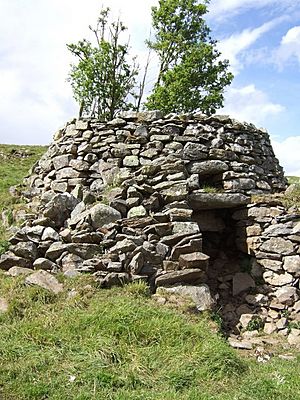
Here are some important places in Aberdeenshire:
- Balmoral Castle, a Scottish home for the British royal family.
- Bennachie, a famous hill.
- Burn O'Vat, a cool rock formation.
- Cairngorms National Park, a large area of mountains and nature.
- Corgarff Castle, an old castle.
- Crathes Castle, a beautiful castle with gardens.
- Causey Mounth, an ancient road.
- Drum Castle, another historic castle.
- Dunnottar Castle, a dramatic ruined castle on a cliff.
- Fowlsheugh Nature Reserve, a place for seabirds.
- Haddo House, a grand country house.
- Huntly Castle, a historic castle ruin.
- Kildrummy Castle, a large ruined castle.
- Loch of Strathbeg, a large coastal lake.
- Lochnagar, a mountain.
- Muchalls Castle, a well-preserved castle.
- Pitfour estate, a historic estate.
- Portlethen Moss, a nature reserve.
- Raedykes Roman Camp, an old Roman site.
- River Dee, a major river.
- River Don, another important river.
- Sands of Forvie Nature Reserve, a coastal area with dunes.
- Slains Castles, Old and New (ruined castles).
- Stonehaven Tolbooth, a historic building in Stonehaven.
- Ythan Estuary Nature Reserve, an important area for wildlife.
Rivers and Climate
Aberdeenshire has many rivers and streams. These include the Cowie Water, River Dee, River Don, and River Ythan. There are also many bays and estuaries along the coast. Some of these are Banff Bay and Ythan Estuary.
Aberdeenshire has a marine west coast climate. This means it has mild summers and cool winters. The area is in the rain shadow of the Grampian Mountains. This means it gets less rain than other coastal areas, about 25 inches (63 cm) each year. Near the coast, the North Sea makes temperatures more moderate. Coastal areas are usually cooler in summer and warmer in winter than inland areas. Coastal areas can also get haar, which is a type of coastal fog.
Famous People from Aberdeenshire
- John Skinner (1721–1807), a writer and poet. He wrote the famous song "Tullochgorum".
- Hugh Mercer (1726–1777), born near Rosehearty. He was a general in the Continental Army during the American Revolution.
- Alexander Garden (1730–1791), born in Birse. He was a famous naturalist and doctor. The gardenia flower is named after him.
- George MacDonald (1824–1905), an author, poet, and theologian. He was born and grew up in Huntly.
- Dame Evelyn Glennie (born 1965), born and raised in Ellon. She is a world-famous percussionist. She is deaf but has shown that this does not stop her amazing musical talent.
- Evan Duthie (born 2000), an award-winning DJ and music producer.
- Peter Nicol (born 1973), born in Inverurie. He is a former professional squash player who played for Scotland and England.
- Johanna Basford (born 1983), an illustrator and textile designer.
- Iona Fyfe (born 1998), an award-winning Scots singer and musician.
Images for kids
See also
 In Spanish: Aberdeenshire para niños
In Spanish: Aberdeenshire para niños



